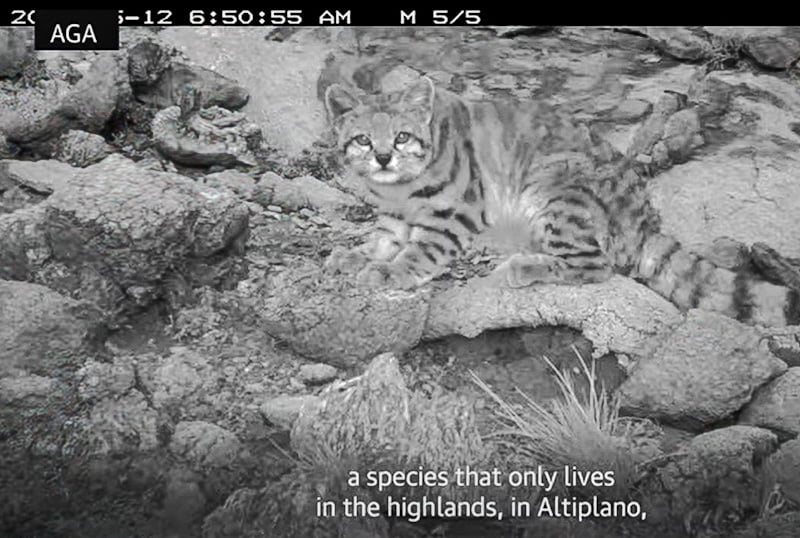This small wild cat species, which looks like a domestic cat, lives in high, rocky, treeless areas in the Andes feeding on viscachas (rodents that look like rabbits). Specimens in museums were taken from elevations above 3,000 metres. And a specimen from Peru was captured at an elevation of 5,100 m. The landscape was barren and rocky with clumps of grass and small bushes.

Recently, knowledge of the distribution of this wild cat has been added to because a conservationist, Bernardo Segura, who lives in Santiago City, Chile, employed a camera trap to capture video of an Andean mountain cat near the city. He says that he can see the habitat of this cat from his apartment window. The video is below. You can see the very rocky terrain that this cat favours. He was delighted to obtain the video. These are rare cats and endangered.
Note: This is a video from another website which is embedded here. Sometimes they are deleted at source which stops them working on this site. If that has happened, I apologise but I have no control over it.
Another reported observation of the cat was on the mountainous Altiplano (plateau) at an elevation of 4,250 m in the Cumbres Calchaquíes in Argentina. The cat was spotted on a rocky hillside where there were many permanent lakes. The climate in that region is very cold with minimum daily temperatures frequently at or below 0°C.
The Altiplano is arid and windswept with little rain. The snow brings moisture during the summer. The vegetation is hardy consisting of grasses and prostrate cushion plants. There might be some minute flowering plants and a few scattered shrubs. The description might provide you with an impression of quite hostile terrain. It reminds me of the habitat of the snow leopard.
In 2002, the authors (the Sunquists) of the book Wildcats of the World said that “there is no information on the mountain cat’s feeding habits”. They therefore speculated and said that this cat probably eats small mammals, birds or lizards. And there are also rabbits and mountain viscachas, hairy armadillos and rodents. And you’ll find ground dwelling birds, ducks, geese and wading birds in the area. These are all potential prey animals. Mountain viscachas are their primary prey depending on their location.
In Argentina, scientists were able to observe an elusive Andean cat which they followed at close range from about 20 to 30 m for two hours. The cat went to a lake to drink. There were ducks on the lake. They followed the cat’s movements. A passing gray fox saw the cat and fled. The fox considered the cat to be a predator but the cat showed no interest in pursuing the fox. The cat then rested for about 20 minutes in a crevice in a large rock, a bit like a cave.
In the further observation in November 1988, which took place near the Salar de Surire in the Chilean Puna at an elevation of about 4,600 m, a wildlife photographer, Gunter Ziesler, watched a colony of mountain viscachas among boulders near a spring. An Andean cat appeared shortly after sunrise. It was there to hunt. The photographer watched for an hour as the cat searched unsuccessfully for prey among the rocks.
The cat appeared to accept the man’s presence as he was only about 20-30 feet away. Andean cats are unhabituated to humans. They don’t realise that humans are dangerous. The same photographer watched an Andean cat kill a viscacha “directly in front of the guardhouse in the Vicuna Reserve Pampa Galares in Peru”. The guards threw stones at the cat to drive it away but they killed it. Unnecessary and cruel.
Tim Sanderson, a small wild cat expert, saw an Andean Mountain cat at Salar de Surire on three different occasions. He was able to approach to as close as 3 metres. The cat was hunting among a colony of mountain viscachas.
In a further observation, a single cat was stalking viscachas as an elevation of 4300 metres on Hacienda Cala Cala in Peru near Azangaro.
These cats were active during the day. Scats from the Andean Mountain cat have mostly been seen in areas of rocky, steep terrain occupied by mountain viscachas.
As at 2002, there was no information about litter size, growth and development of young or their longevity.

